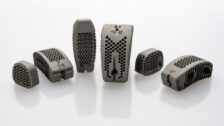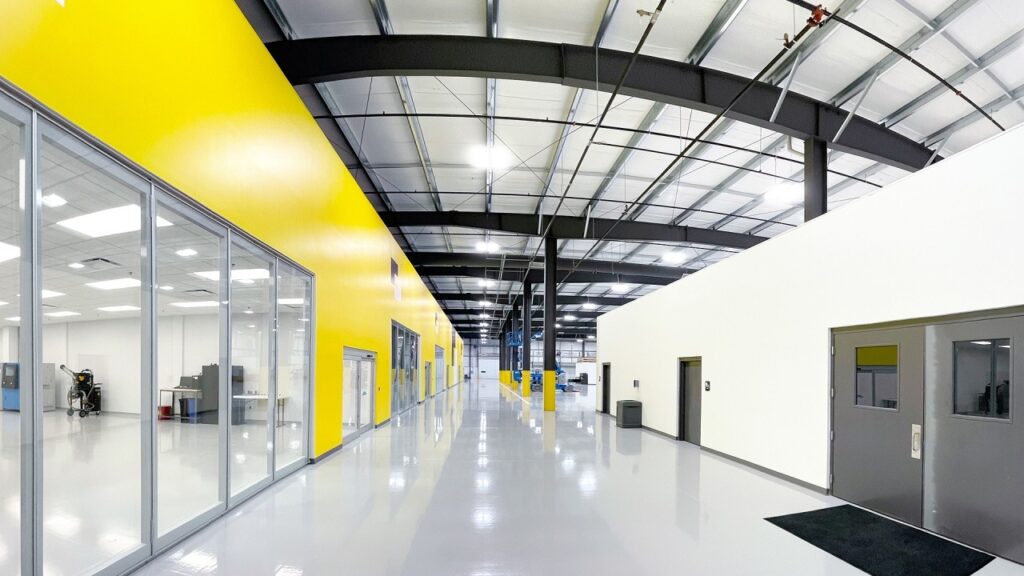
Ruben Wauthle first studied the properties of pure titanium while earning his Ph.D. in mechanical engineering in 2014. Ten years later, the company he co-founded marked the production of 50,000 3D-printed implants made with pure titanium that doesn’t need heat treatment during post-processing. Eliminating this step in the printing process simplifies the production workflow and accelerates time to market for OEMs.
“When we launched Amnovis, no-heat-treatment titanium was one of the key materials we focused on developing,” said Dr. Wauthle, the company’s CEO. “We invested a lot of resources in validating the material because we believed it could be a game changer.”
The orthopedic device industry views 3D printing and additive manufacturing as established technologies. Companies now seek material advancements, cost reductions and improvements in printing efficiency.
“One way we’re addressing this demand is through our pure titanium solution,” he said. “By using pure titanium instead of titanium alloy and eliminating steps like heat treatment, we can achieve the same clinical outcomes with a more streamlined and cost-effective process.”
Pure Benefits
Amnovis worked to develop the no-heat treatment process for pure titanium for over a year to bring it to a validated state. The company performed extensive tensile testing and other processes to fine-tune the approach.
Dr. Wauthle explained that titanium alloy is typically used in 3D-printed medical devices with hot isostatic pressing (HIP), which is the gold standard for post-processing. “However, HIP is a costly process that’s usually outsourced,” he explained. “It’s a specialized technology that adds cost, lead time and complexity to the production workflow.”
Dr. Wauthle said excluding heat treatments of 3D-printed titanium parts generally shaves at least two weeks off lead times and 10% to 20% off production costs.
Amnovis knew that eliminating heat treatments would also allow for the use of pure titanium instead of titanium alloy in the production of orthopedic implants. “Although pure titanium has slightly lower strength, it offers higher ductility, which has its advantages,” Dr. Wauthle said. “Another key benefit is that pure titanium contains no alloying components, which translates into higher biocompatibility compared to titanium alloy.”
Dr. Wauthle said the tensile strength of titanium alloy is around 800 MPa. He noted that pure titanium’s tensile strength is just above 200 MPa. That’s a significant gap between the two. However, Amnovis’ optimized 3D printing process has increased the mechanical properties of pure titanium to fall between these two extremes, closer to the material properties of Grade 4 titanium.
Lattice structures produced with titanium alloy are much stronger under static compression, but pure titanium outperforms the alloy after 100,000 cycles of fatigue testing, according to Dr. Wauthle.
“While pure titanium loses a bit in static tensile strength, it exhibits significant benefits in elongation,” he said. “Higher elongation, or ductility, generally improves an implant’s fatigue life properties. Thanks to its ductility, the pure titanium structure deforms rather than breaks and demonstrates a completely different fatigue behavior.”
Amnovis has also patented “deformable implant” technology based on the high ductility of pure titanium. The material allows for the creation of deformable implants, which opens new possibilities in surgical approaches and personalized medicine.
For example, Amnovis can coat an acetabular cup with a 3D-printed porous structure made from the pure titanium it developed. “The porous structure can be deformed, meaning surgeons can hammer it into bone or mold it preoperatively to achieve a specific fit,” Dr. Wauthle said. “It’s a flexible solution that merges the benefits of standardized implant production with personalized surgery.”
Engineering Excellence
Interest in the 3D printing of bioceramic implants is increasing, and Himed is positioned to capitalize on the emerging market opportunity. The company specializes in the manufacturing of calcium phosphates, which are produced with various properties when used in composite form or when interacting with cells in the body.
In addition to their use as bulk materials, calcium phosphate ceramics can be applied to texture the surfaces of metal implants. Himed offers several options, including a hydroxyapatite (HA) coating on metal that enhances osseointegration. The company also uses color anodization or MATRIX MCD apatite abrasive to texture titanium implants and improve their bonding with bone.
Himed recently partnered with Lithoz, a company that specializes in high-resolution 3D printers, to expand the range of bioinks that orthopedic manufacturers can use to develop products with complex shapes and various porosities.
Last year, the companies launched the Bioceramics Center of Excellence (BCoE) to allow OEMs to prototype and test new implant designs without significant investment in 3D printing equipment. The move was made in response to growing interest in bioceramic materials, which help the body’s natural healing process for the development of hard tissues and new bone.
Himed and Lithoz employ bioceramic materials and 3D printing to transform an engineering design into a physical part. The BCoE’s engineers collaborate with OEMs to analyze initial prototypes and ensure they meet the requirements for specific treatment applications.
Craig Rosenblum, President of Himed, said there are multiple steps to the process. First, a CAD file is created for the prototype. The design software then generates a rendering of the device so it can be printed layer by layer.
“The BCoE makes it easier to explore what 3D printing can offer, helping companies determine whether it’s suitable for their application or next-generation device,” Rosenblum said. “A startup with a highly disruptive implant design could approach us if they need proof-of-concept testing to secure investment funding, and we can help facilitate that.”
A significant advantage of 3D printing is the ability to make small design changes by simply adjusting the CAD file and reprinting. This creates a faster iteration cycle. For instance, an orthopedic fixation company might be designing an implant made entirely of HA. The company might want to evaluate different diameters and geometries to find the best option for cell integration and bone fixation.
“With 3D printing, we can test multiple pore geometries within the same print run, speeding the design iteration process,” Rosenblum said.

Paragon Medical signaled its commitment to expansion of its 3D printing capacity by opening a dedicated additive manufacturing facility in 2023.
Growth Mindset
Mike Street, Principal Engineer at Paragon Medical, pushed the company to make significant investments in additive manufacturing beginning in 2020 when he recognized the technology’s potential. “We had always dabbled in 3D printing, but it had been somewhat of a side project,” he said. “We identified an emerging market opportunity and proposed a substantial investment in new equipment.
Paragon Medical brought in 3D Systems’ printers specifically to produce titanium implants with an initial focus on a shoulder system the company was launching. “We acquired four machines and validated them quickly, but soon realized that their capacity wouldn’t be sufficient to support our needs,” Street said.
Part of the solution involved the company constructing a 40,000-square-foot facility dedicated to additive manufacturing, which opened in June 2023. Street also wanted to solve a broken supply chain and worked on vertically integrating the company’s additive manufacturing processes, especially for titanium-printed orthopedic implants, which typically require HIP.
He proposed a $5 million investment to acquire HIP equipment, and in August, Paragon Medical successfully installed and validated the equipment for producing orthopedic implants. Operating the equipment onsite allows the company to finish 3D-printed titanium parts without relying on outside vendors, cutting production times in half.
Street said titanium tends to absorb elements during HIP if contaminants are present, leading to the formation of a brittle microstructure known as alpha case. He noted that this contamination can result in titanium parts absorbing oxygen, which can lead to fractures due to the brittleness of the alpha case.
“By having HIP capabilities onsite, we can control what goes into the process and ensure that titanium is not exposed to contaminants,” Street said. “We’re not outsourcing the process, so we know precisely which materials are being used.”
Paragon Medical is conducting alpha case testing and collaborated with the manufacturer of its hot isostatic presses to develop a new “clean” HIP cycle. The clean cycle allows for the placement of titanium parts directly into the chamber without the need for stainless steel bags, which traditionally protect against contaminants.
“Our printed parts emerge completely clean,” Street said. “The process is also fully monitored to ensure that gas levels in the chamber are controlled throughout the cycle, making it a very efficient production method.”
Spine remains a mainstay of 3D-printed implant designs. However, Paragon Medical has seen a significant uptick in the use of additive manufacturing to produce implants for smaller joint replacements such as total shoulders and ankles. The company is also seeing increased adoption of 3D printing technologies to produce implants for small extremities, including toes and hands.
Additive manufacturing is being used more in hip and knee replacement applications, but Street said competing with traditional manufacturing methods, like forging and casting, remains a challenge. “Converting a part designed for forging to an additive product without thoughtful design changes doesn’t yield worthwhile results,” he said. “Additive manufacturing is most effective when it’s tailored to designs that leverage its unique capabilities.”
The orthopedic 3D printing market is maturing, and pricing is becoming more competitive. Street noted that new technologies are emerging that could help manufacturers compete more effectively with forgings and castings.
Paragon Medical is actively exploring ways to enhance its competitiveness with traditional manufacturing methods for large joints due to their high volume. “Our goal is to make printed components that are superior or more cost-effective than forgings and castings,” Street said.
According to Street, recent European Union regulations that classify cobalt chrome as a carcinogen have caused a noticeable market shift toward the use of titanium to produce femoral components for knee implants, which aren’t ideal for traditional forging processes. He also noted that casting titanium is a challenging and highly specialized process that many manufacturers avoid.
“To address these challenges, we’re focusing on creating cementless solutions by printing lattice structures onto thermal components before machining them,” Street said. “That leverages the advantages of additive manufacturing and aligns with the growing demand for titanium in orthopedic applications.”
The company is also employing binder jet technology to develop single-use stainless steel instrumentation. This approach combines the benefits of binder jet technology and injection molding to produce cutting instruments at a price point that makes it feasible to manufacture and discard them after use. “That’s particularly appealing for ASCs that don’t have the resources to reprocess reusable instruments,” Street said.
Paragon Medical’s mid-sized binder jet machine produces parts approximately 10 times faster than standard laser printing technology. In a full production-sized machine, that speed can increase to 30 times faster.
Street said that binder jet printing offers greater design flexibility, allowing for the creation of complex geometries without the need for supports such as overhangs and undercuts. “Although this technology is relatively new and not yet widely adopted in the medical field,” he said, “we’re optimistic about the interest it will generate.”
DC
Dan Cook is a Senior Editor at ORTHOWORLD. He develops content focused on important industry trends, top thought leaders and innovative technologies.




